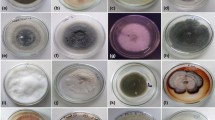Abstract
Fungal species that establish an endophytic role inside the tissues of medicinal plants are known to produce a wide range of biologically active metabolites and enzymes. In the present study, the most dominant and representative endophytic fungal species of five ethno-medicinal plants prevalent in the pristine sacred forests of Meghalaya, were screened for their ability to produce amylase, cellulase, protease, lipase, and xylanase. Each of endophytic fungal isolates showed a wide range of enzyme activity. Mycelial biomass generation and root colonization, in addition to the enzyme activity of the endophytic fungal isolates, provided insights into their probable origin and ecological roles within the plant host.
Similar content being viewed by others
References
Pilnik, W. and F. M. Rombouts (1985) Polysaccharides and food processing. Carbohyd. Res. 142: 93–105.
Falch, E. A. (1991) Industrial enzymes — developments in production and application. Biotechnol. Adv. 9: 643–658.
Rao, M. B., A. M. Tanksale, M. S. Ghatge, and V. V. Deshpand (1998) Molecular and biotechnological aspects of microbial proteases. Microbiol. Mol. Biol. Rev. 62: 597–635.
Carrim, A. J. I., E. C. Barbosa, and J. D. G. Vieira (2006) Enzymatic activity of endophytic bacterial isolates of Jacaranda decurrens Cham. (Carobinha-do-campo). Braz. Arch. Biol. Technol. 49: 353–359.
Stierle, A., G. A. Strobel, and D. Stierle (1993) Taxol and taxane production by Taxomyces andreanae. Sci. 260: 214–216.
Strobel, G. A., X. Yang, and J. Sears (1996) Taxol from Pestalotiopsis microspora, an endophytic fungus of Taxus wallichiana. Microbiol. 142: 435–440.
Strobel, G. A., D. C. Manker, and J. Mercier (2005) Endophytic fungi and methods of use. www.freepatentsonline.com/6911338.html
Meletiadis, J., J. W. Mouton, and J. F. Meis (2001) Colorimetric assay for antifungal susceptibility testing of Aspergillus Species. J. Clin. Microbiol. 39: 3402–3408.
Downie, B., H. W. M. Hilhorst, and J. D. Bewley (1994) A new assay for quantifying endo-β-mannanase activity using congo red dye. Phytochem. 36: 829–835.
Pointing, S. B. (1999) Qualitative methods for determination of ligno-cellulolytic enzyme production by tropical fungi. Fungal Divers 2: 17–33.
Ivanova, D., N. Reilly, S. McKenna, M. Clary, and V. Stout (2009) Establishing a quantitative assay for caseinase and lipase activity in selective media using seven different strains of pathogenic bacterium Pseudomonas tolaasii. Arizona state university. sols.asu.edu/symposium/2009/pdf/ivanova.pdf.
Miller, G. L. (1959) Use of dinitrosalicylic acid reagent for determination of reducing sugar. Biotechnol. Bioeng. Symp. 5: 193–219.
Medina, V. F., P. M. Jeffers, S. L. Larson, and W. Perez (2000) Sterilization of plants for phytoremediation studies by bleach treatment. Int. J. Phytorem. 2: 287–295.
Rai, M. and A. Varma (2005) Arbuscular mycorrhiza-like biotechnological potential of Piriformospora indica, which promotes the growth of Adhatoda vasica Nees. Elect. J. Biotechnol. 8.: 1–4.
Giovannetti, M. and B. Mosse (1998) An evaluation of techniques for measuring vesicular-arbuscular mycorrhizal infection in roots. New Phytol. 84: 489–500.
Cappuccino, J. G. and N. Sherman (1996) Microbiology: A Laboratory Manual. p. 186. 4th ed. Benjamin-Cummings, Menlo Park, USA.
Huang, C. H., F. L. Lee, and C. J. Tai (2009) The β-tubulin gene as a molecular phylogenetic marker for classification and discrimination of the Saccharomyces sensu stricto complex. Anton Van Leeuwenhoek 95: 135–142.
Tamura, K., J. Dudley, M. Nei, and S. Kumar (2007) MEGA4: Molecular evolutionary genetics analysis (MEGA) software version 4.0. Mol. Biol. Evol. 24: 1596–1599.
Lumyong, S., P. Lumyong, E. H. C. McKenzie, and K. D. Hyde (2002) Enzymatic activity of endophytic fungi of six native seedling species from Doi Suthep-Pui national park,Thailand. Can. J. Microbiol. 48: 1109–1112.
Maria, G. L., K. R. Sridhar, and N. S. Raviraja (2005) Antimicrobial and enzyme activity of mangrove endophytic fungi of southwest coast of India. J. Agril. Technol. 1: 67–80.
Abdel-Raheem, A. and C. A. Shearer (2002) Extracellular enzyme production by freshwater ascomycetes. Fungal Divers 11: 1–19.
Johnson, C. R., L. Salas, R. Vicuna, and T. K. Kirk (1993) Extracellular enzyme production and synthetic lignin mineralization by Ceniponropsis subvermispora. Appl. Environ. Microbiol. 59: 1792–1797.
Bhagobaty, R. K. and S. R. Joshi (2011) Multi-loci molecular characterisation of endophytic fungi isolated from five medicinal plants of Meghalaya, India. Mycobiol. 39: 71–78.
Author information
Authors and Affiliations
Corresponding author
Rights and permissions
About this article
Cite this article
Bhagobaty, R.K., Joshi, S.R. Enzymatic activity of fungi endophytic on five medicinal plant species of the pristine sacred forests of Meghalaya, India. Biotechnol Bioproc E 17, 33–40 (2012). https://doi.org/10.1007/s12257-011-0453-4
Received:
Accepted:
Published:
Issue Date:
DOI: https://doi.org/10.1007/s12257-011-0453-4




